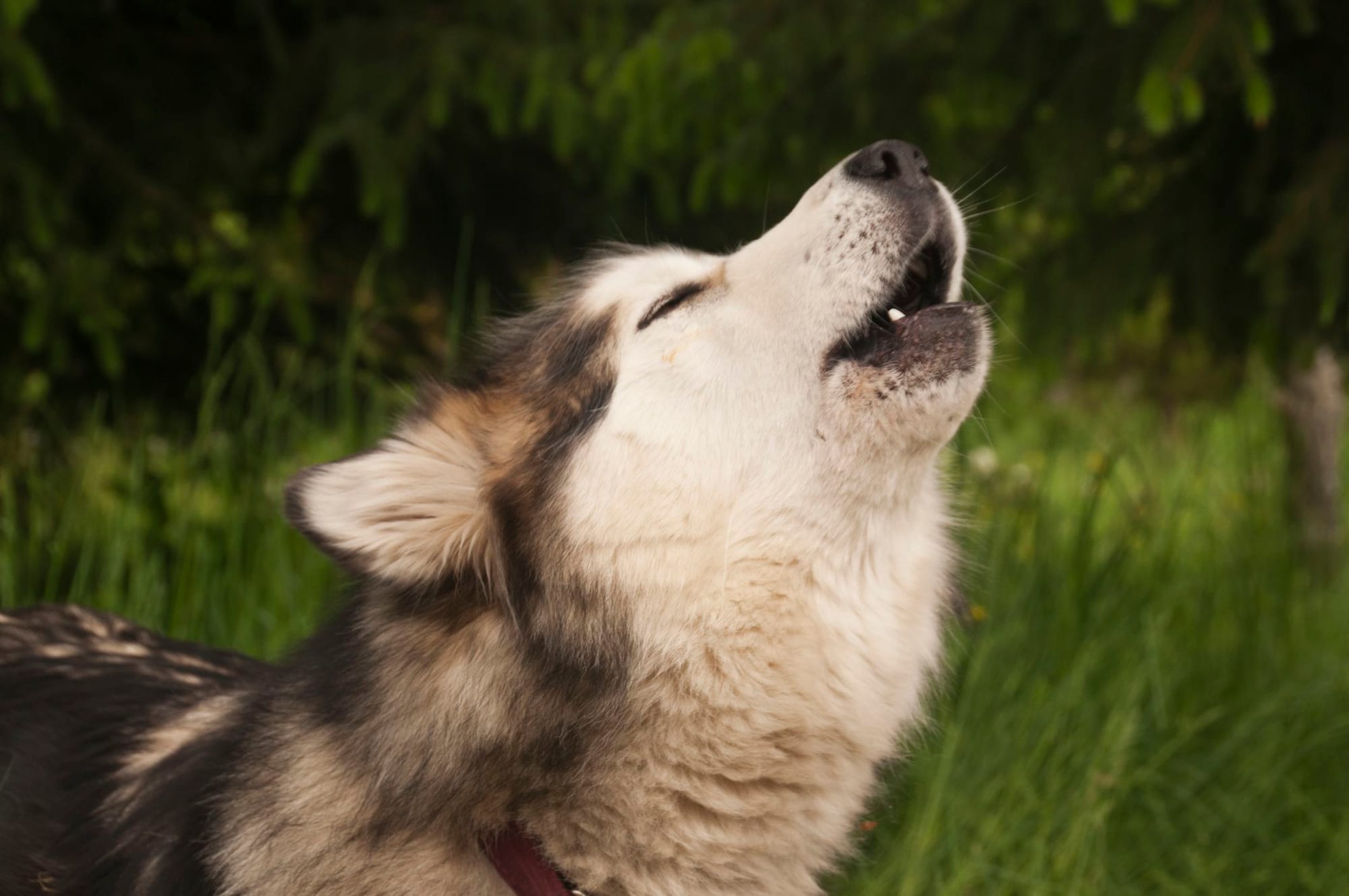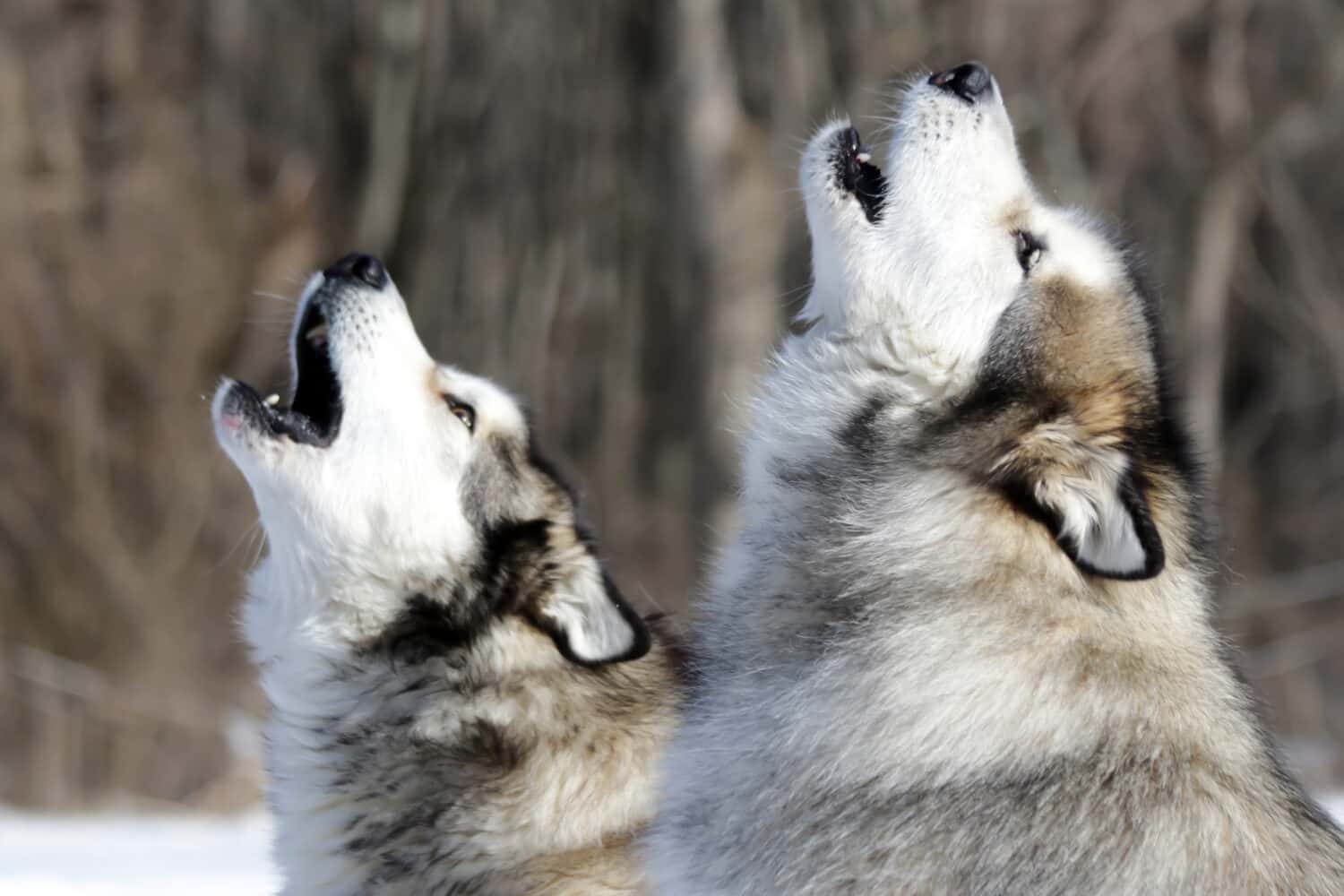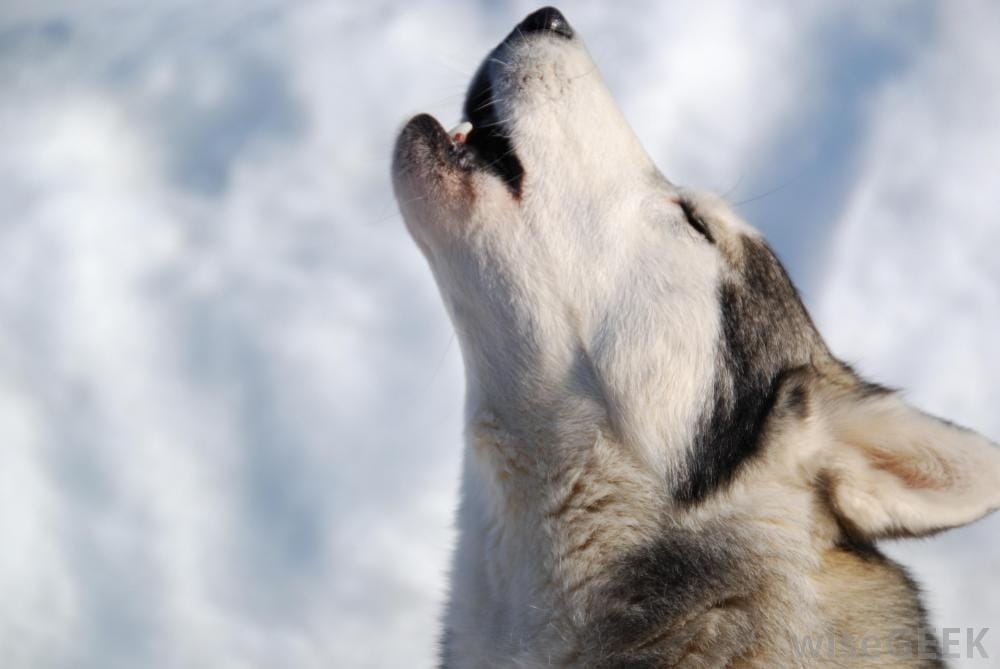Alaskan Malamutes are a beautiful breed of dog that are known for their strength, loyalty, and intelligence. One of the most distinctive traits of this breed is their vocalization, which includes a range of sounds from barks to howls. Many people wonder if Alaskan Malamutes howl and what causes them to do so.

The answer is yes, Alaskan Malamutes do howl. In fact, howling is a natural behavior for this breed. Howling is a form of communication that allows them to connect with other dogs and their owners. It's also a way for them to express their emotions, such as excitement, anxiety, or loneliness. Understanding why Alaskan Malamutes howl can help owners better care for their pets and strengthen their bond.
Alaskan Malamute Vocalization Characteristics
Alaskan Malamutes are known for their distinct vocalizations. They have a wide range of vocalizations, including howling, whining, and growling. Here are some characteristics of their vocalizations:

- Howling: Alaskan Malamutes are known for their howling, which is a long, high-pitched sound that can be heard from a distance. They howl to communicate with other dogs and their owners. Howling is also a way for them to express their emotions such as loneliness, boredom, or excitement.
- Whining: Alaskan Malamutes also whine to communicate with their owners. Whining is a higher pitched sound than howling and is often used to express their desire for attention or to indicate discomfort.
- Growling: Alaskan Malamutes growl when they feel threatened or to show dominance. Growling is a low, rumbling sound that can be accompanied by baring their teeth.
It is important to note that while Alaskan Malamutes are vocal dogs, excessive barking is not a common trait for them. They are generally a quiet breed, but their vocalizations can be quite loud and carry over long distances.
Overall, Alaskan Malamutes have a unique vocalization style that allows them to communicate effectively with their owners and other dogs. Understanding their vocalization characteristics can help owners better understand their needs and emotions.
Reasons Why Alaskan Malamutes Howl
Alaskan Malamutes are known for their distinctive howling. This behavior may seem unusual to some people, but it is perfectly normal for this breed. There are several reasons why Alaskan Malamutes howl, including communication, response to stimuli, ancestral traits, and separation anxiety.
Communication
One of the primary reasons why Alaskan Malamutes howl is to communicate with other dogs. Howling is a way for dogs to express themselves and convey messages to other dogs. Alaskan Malamutes are pack animals, and howling helps them to stay in touch with other members of their pack. Howling can also be a way for dogs to signal their location to other dogs in the area.
Response to Stimuli
Alaskan Malamutes may also howl in response to certain stimuli, such as sirens or other loud noises. This behavior is known as "singing" and is a common trait among many northern breeds. Some Alaskan Malamutes may also howl when they are excited or happy, such as when their owners come home or when they are playing with other dogs.
Ancestral Traits
Alaskan Malamutes are a breed that has been around for thousands of years. They were originally bred as working dogs in the Arctic regions of North America, where howling was a common way for dogs to communicate with each other. As a result, howling is deeply ingrained in the breed's ancestral traits.
Separation Anxiety
Finally, Alaskan Malamutes may also howl when they are experiencing separation anxiety. This is a common issue for many dogs, and howling can be a way for them to express their distress. If your Alaskan Malamute is howling excessively when you leave the house, it may be a sign that they are experiencing separation anxiety and may need some extra attention and training.
In conclusion, Alaskan Malamutes howl for a variety of reasons, including communication, response to stimuli, ancestral traits, and separation anxiety. Understanding why your dog is howling can help you to better communicate with them and provide them with the care and attention they need.
Differences Between Howling and Other Vocalizations
Alaskan Malamutes are known for their vocalizations, which include barking, growling, whining, and howling. However, there are significant differences between these vocalizations that are important to understand.
Howling
Howling is a unique vocalization that is distinct from barking and growling. Alaskan Malamutes howl to communicate with other dogs or their owners over long distances. Howling is often used as a form of social bonding, and it can also be a sign of distress or anxiety.
When an Alaskan Malamute howls, it typically starts with a low-pitched sound that gradually rises in pitch. The howl may be long or short, and it can be repeated several times in succession. Howling is a natural behavior for Alaskan Malamutes, and it is not a sign of aggression or dominance.
Barking
Barking is another common vocalization for Alaskan Malamutes. Unlike howling, barking is a short, sharp sound that is used to communicate a variety of messages. Alaskan Malamutes may bark to alert their owners of danger or to express excitement or frustration.
Growling
Growling is a low-pitched sound that is often associated with aggression or fear. Alaskan Malamutes may growl when they feel threatened or when they are protecting their territory. Growling is a warning that should not be ignored, as it can escalate into more aggressive behavior.
Whining
Whining is a high-pitched sound that is often used to express anxiety or frustration. Alaskan Malamutes may whine when they are left alone or when they are in a new environment. Whining can also be a sign of illness or injury, so it is important to address this behavior if it persists.
In summary, Alaskan Malamutes use a variety of vocalizations to communicate with their owners and other dogs. Howling is a unique behavior that is used for social bonding and long-distance communication, while barking, growling, and whining are used to convey different messages. By understanding these vocalizations, owners can better communicate with their Alaskan Malamutes and provide them with the care and attention they need.
Training Alaskan Malamutes to Manage Howling

Alaskan Malamutes are known for their howling, which is a natural behavior for them. However, excessive howling can be a nuisance for neighbors and owners. Fortunately, there are ways to train Alaskan Malamutes to manage their howling behavior.
Positive Reinforcement
Positive reinforcement is a training technique that involves rewarding desired behavior. When training Alaskan Malamutes, positive reinforcement can be used to reward them for not howling excessively. For example, when the dog is quiet, the owner can give them a treat or praise them. Over time, the dog will learn that being quiet is a good thing and will be more likely to exhibit this behavior.
Addressing Underlying Causes
Sometimes, excessive howling can be a sign of an underlying issue, such as separation anxiety or boredom. Addressing these underlying causes can help reduce howling. For example, if the dog has separation anxiety, the owner can gradually increase the amount of time they spend away from the dog, so the dog gets used to being alone. If the dog is bored, the owner can provide them with more toys and activities to keep them occupied.
Desensitization Techniques
Desensitization techniques involve gradually exposing the dog to the stimulus that triggers their howling, so they become less reactive to it. For example, if the dog howls when they hear sirens, the owner can gradually expose the dog to recorded sirens at a low volume, then gradually increase the volume over time. This can help the dog become less reactive to sirens and reduce their howling behavior.
In conclusion, training Alaskan Malamutes to manage their howling behavior requires patience, consistency, and a good understanding of the underlying causes. By using positive reinforcement, addressing underlying causes, and desensitization techniques, owners can help their Alaskan Malamutes become better-behaved and reduce excessive howling.
Howling and Malamute Health
Alaskan Malamutes are known for their distinct howling, which is a natural behavior for them. However, excessive howling or changes in howling patterns may indicate underlying health issues or stress.
Indicators of Health Issues
Changes in howling patterns may indicate underlying health issues in Alaskan Malamutes. For instance, if a Malamute suddenly starts howling more frequently or howls in a different tone, it may indicate pain or discomfort. Malamutes may also howl excessively due to thyroid or other hormonal imbalances, which can affect their overall health.
Stress-Related Howling
Stress can also cause Alaskan Malamutes to howl excessively. Malamutes may howl when they are anxious, lonely, or bored. In some cases, excessive howling may even be a sign of separation anxiety. Malamutes that are stressed may also exhibit other symptoms, such as destructive behavior or loss of appetite.
To ensure that your Alaskan Malamute is healthy and happy, it is important to monitor their howling patterns and behavior. If you notice any changes or excessive howling, it is recommended to consult with a veterinarian to rule out any underlying health issues and to address any potential stressors in your Malamute's environment.
Howling in Malamute Puppies vs. Adults
Alaskan Malamutes are known for their distinctive howling, which is often said to resemble a wolf's howl. However, the frequency and intensity of howling can vary depending on the age of the Malamute.

Puppies
Malamute puppies typically start howling at around 2-3 weeks old. At this age, their howls are usually high-pitched and short, and they may not be able to sustain a howl for very long. Puppies howl to communicate with their mother and littermates, and to express discomfort or hunger.
As they grow older, Malamute puppies will start to develop their own distinct howls and may begin howling more frequently. However, their howls are still likely to be shorter and less intense than those of adult Malamutes.
Adults
Adult Malamutes are known for their powerful, deep howls that can be heard from a distance. They howl to communicate with other Malamutes, to express excitement or frustration, and to alert their owners to potential danger.
Adult Malamutes may howl more frequently than puppies, and their howls are likely to be longer and more sustained. However, the frequency and intensity of howling can vary depending on the individual dog and their environment.
Overall, howling is a natural behavior for Malamutes of all ages, and is an important form of communication for these social animals.
The Role of Environment in Malamute Howling
Alaskan Malamutes are known for their howling, a vocalization that is deeply ingrained in their nature. However, the frequency and intensity of their howling can be influenced by various environmental factors.
One of the most significant environmental factors that affect Malamute howling is temperature. These dogs have a thick, double-layered coat that keeps them warm in cold temperatures. As a result, they tend to be more active and vocal during the winter months when the temperature drops. In contrast, they may be less vocal during the summer months when the temperature is higher.
Another environmental factor that can influence Malamute howling is their living situation. Malamutes are pack animals and thrive in social environments. When they are kept in isolation or in a small space, they may howl more frequently as a way to communicate with their owners or other dogs. On the other hand, Malamutes that live in larger packs or in a more social environment may not need to howl as much.
Lastly, Malamute howling can also be influenced by their level of activity. These dogs are highly energetic and require a lot of exercise. When they are not getting enough physical activity, they may become restless and howl more frequently. Conversely, when they are getting enough exercise, they may be less likely to howl.
In conclusion, while Malamutes are known for their howling, the frequency and intensity of their vocalizations can be influenced by various environmental factors such as temperature, living situation, and level of activity.
Frequently Asked Questions

- Q1: Why do Alaskan Malamutes often howl at sirens?
- Alaskan Malamutes are known to have a strong instinct to howl, and sirens can trigger this behavior. This is because the sound of a siren resembles the howling of a wolf, which is a close ancestor of the Alaskan Malamute. Howling is also a way for them to communicate with other dogs and their owners.
- Q2: Is it common for Alaskan Malamutes to howl more during certain times of the day?
- Alaskan Malamutes can howl at any time of the day or night, but they may be more active during the early morning or late evening hours. This is because these are the times when they are most alert and active.
- Q3: What are the differences between Alaskan Malamute and Husky vocalizations?
- Alaskan Malamutes and Huskies are both known for their vocalizations, but there are some differences between the two. Alaskan Malamutes tend to have a deeper and more resonant howl, while Huskies have a higher-pitched and more varied vocal range.
- Q4: Can Alaskan Malamute howling be a sign of distress or discomfort?
- Yes, excessive howling in Alaskan Malamutes can be a sign of distress or discomfort. If an Alaskan Malamute is howling excessively, it may be a sign that they are experiencing separation anxiety, boredom, or other types of stress.
- Q5: How can an owner discourage excessive howling in Alaskan Malamutes?
- Owners can discourage excessive howling in Alaskan Malamutes by providing them with plenty of exercise and mental stimulation. They can also train their Alaskan Malamutes to respond to verbal commands and reward them for good behavior.
- Q6: Do Alaskan Malamutes typically bark or are they more prone to howling?
- Alaskan Malamutes are more prone to howling than barking. However, they may still bark on occasion, especially if they are trying to alert their owners to something or communicate with other dogs.